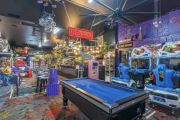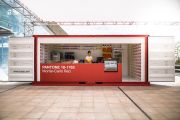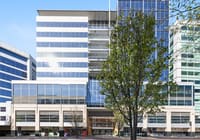
In the shopping centre evolution, experience is the new anchor
Regional shopping centres are amping up the consumer experience by adding dining, wellness, culture and even sporting activities to ensure shoppers stay longer and spend more, new CBRE research shows.
CBRE’s Regional Shopping Centres Reimagined report, shows the evolution of regional shopping centres as experience-led destinations and vital community hubs.
From Barbie cafes to basketball courts and wellness clubs, centres around the country are throwing a variety of experiential assets into their tenancy mix.
In this retail report, “regional” is defined by size rather than location. According to the Property Council of Australia, a regional shopping centre is 50,000 to 85,000 square metres with at least one full-line department store, one or more discount department stores, one or more supermarkets, and up to 150 speciality stores.
Sheree Griff, CBRE’s head of retail property management and place advisory, says the strategy to enrich the shopping centre experience is directly linked to the COVID-19 pandemic and the competitive strategy against online shopping.
“COVID fundamentally changed things – as a consumer we came to really appreciate social interaction,” says Griff.
“That’s one of the reasons that while online shopping is growing, it’s not growing as fast as the bricks-and-mortar experience of shopping and why every retailer is now looking at how they can have a brand presence that has an experience element to it.
“If you look holistically at what makes a place thrive, whether it’s a mixed-use asset or a precinct, social engagement is fundamentally what attracts people to hang out – to socialise, and meet and dwell longer and experience. And when you do that, you’re likely to spend more, buy a meal, a glass of wine or meander more through the shopping centre and potentially buy more.”
The CBRE report highlights four regional shopping centres that are paving the way for the new retail experiential strategy of Eat, Escape, Energise, Engage and Entertain.
- The Hunter & Gatherer Market Precinct in the Pacific Epping shopping centre in Melbourne. “Street food style stalls and Instagram-worthy cafes combine to deliver vibrant dining experiences, turning the centre into a social hub.”
- The Rooftop Oasis and Urban Garden in Westfield Mount Gravatt shopping centre in Brisbane. “A lush, calm, nature-infused retreat is on offer for visitors to unwind, meet friends or work remotely.”
- The Virgin Active Wellness Club at Westfield Bondi Junction in Sydney. “With premium fitness and holistic health outlets, lifestyle offerings are woven into the retail environment, making the centre a daily destination, not just a shopping trip.”
- The Social Quarter in Chadstone Shopping Centre in Melbourne. “A Malibu Barbie Cafe activation with immersive VR experiences and family-friendly entertainment zones offers playful experiences to drive foot traffic and social sharing.” Lost & Found, a “captivating” art exhibition by CJ Hendry and hosted by this centre, was also singled out as a way to deliver an immersive, multi-site experience.
CBRE data reveals how well the new tenancy mix in regional shopping centres is working.
Since 2019, fashion and accessories have lost 3 percentage points of total square metres, while food and beverage and mini-majors have gained 2 percentage points.
Mini-majors (specialty stores around 1000 square metres that have strong online sales but are customer drawcards for shopping centres, for example, JB Hi-Fi and Kathmandu) remain the largest category in the tenant mix evolution, at 32 per cent compared to fashion, and food and beverage at 30 per cent.
“Mini-majors, often focusing on convenience and leveraging services like click-and-collect, drive consistent foot traffic and have higher productivity per square metre than department stores and specialties, which makes them valuable anchors for shopping centres,” explained Griff.
Looking ahead, the report says retail turnover is projected to grow 3.6 per cent per annum for discretionary spending and 4.5 per cent for food sales to 2030, supporting long-term income and centre performance.
Kate Bailey, CBRE head of retail research, said the uplift in food and beverage reflected the growing role of dining and social experiences as key drivers of visitation, as centres repositioned to compete with online retail.
“While discretionary retail faces growing competition from e-commerce, food spend continues to grow steadily, underpinned by its experiential, social, and in-person nature, making it a key driver of in-store growth,” said Bailey.
“For landlords, this means food isn’t just a leasing category, it’s a strategic anchor. Investment in dining precincts delivers stronger visitation, longer dwell time and higher cross-spend across the centre.”
The latest experiential opportunity being explored by the nation’s shopping centres is sports-led activations. Bailey said this category was emerging as a powerful new driver of engagement, with sports facilities such as basketball courts, futsal pitches, pickleball arenas, and pop-up tournaments already taking shape.
The Forest Hill Chase shopping centre opened in Melbourne’s eastern suburbs in 1964, but today it’s a leader in transforming retail centres into multipurpose community hubs.
The centre has submitted a Development Application to create a competition-grade, three-court basketball stadium in collaboration with the local Nunawading Basketball and Basketball Victoria.
In another example, the Emporium Melbourne’s rooftop Stephen Curry Court, part of Rebel’s flagship wellbeing destination, brings an NBA-sized court to the city skyline, merging sport and retail in a uniquely interactive way, Bailey said.
“These activations mark the next evolution for regional shopping centres, transforming them into true community hubs … blurring the lines between retail, recreation and lifestyle.”










